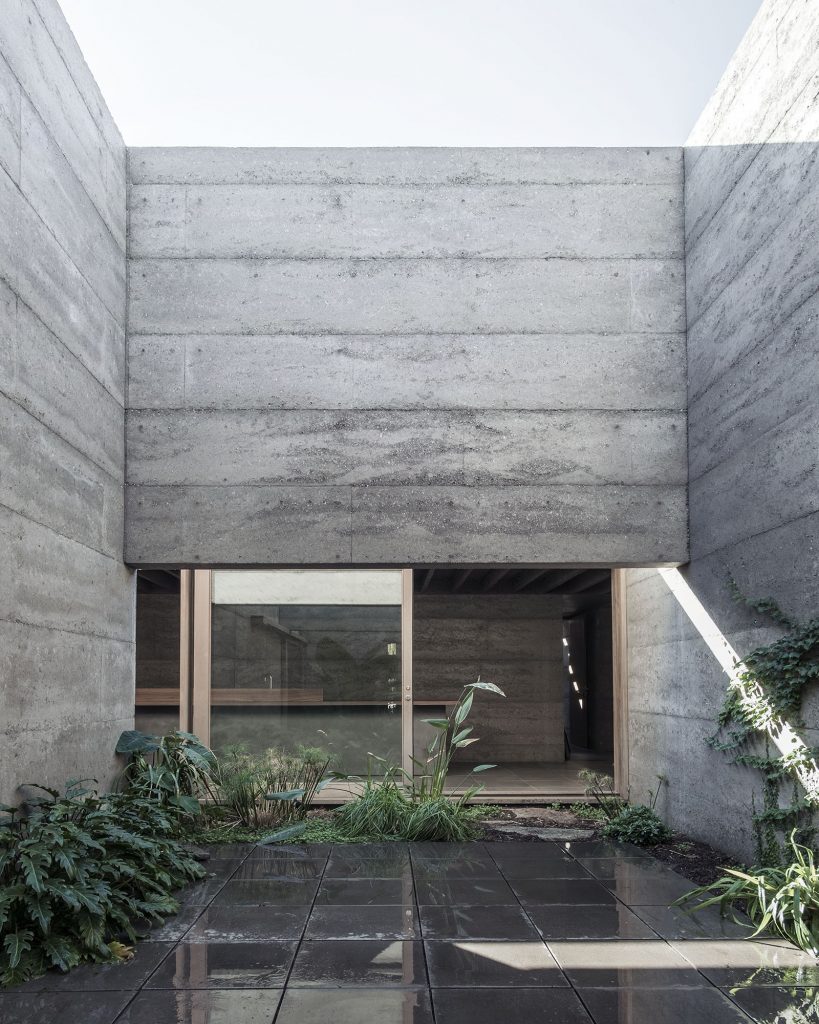
“An Inward and Protected World”: The Cloister House by MORQ
MORQ describe The Cloister House as an “enclosed house” and this is the fundamental idea around which the rest of the project coalesces. While the spaces are arranged around a central void, the name Cloister House is not so much a typological reference to the cloister but instead a reference “to the idea of an enclosure and the creation of an inward and protected world” says MORQ.
The idea of the cloister and the conception of the house as a place of retreat is felt not only in the spatial arrangement but in the structure’s raw materiality and treatment of light and space. Rammed concrete walls (created in the ancient technique called ‘pise’) are unadorned with further embellishment, the material’s textural qualities and sheer mass creating a powerful presence.
It is reflective of MORQ’s considered approach to materiality, as Andrea explains “We believe the use of only a few materials generates a sort of harmonised background that in turn places the emphasis on the space and the inhabitants’ lives within”. The Cloister House’s material palette is limited to the rammed concrete, washed timber for the roof structure and joinery and concrete tiles for the floor (an either ascetic or luxuriant display of restraint, depending on one’s perspective).
This controlled use of materials is echoed in the exceptional command over space and light. Structural proportions are designed to be complemented by precise insertions that regulate the amount and direction of the natural light from the central courtyard.
The house if focused inward around a central private courtyard that provides natural light into the adjacent spaces.
“Structure, matter and light are inextricably linked”, says Emiliano. “The proportion of these rooms, their relationships and the natural light define the atmosphere and create a variation of scenarios.” Light is reflected by the courtyard walls throughout the day and chromatically filtered by the vegetation, alighting here and there, serving to literally and figuratively highlight particular details of the design.
The monolithic concrete illuminated by carefully directed rays of light creates a monastic atmosphere, making the project’s name particularly apt. Pared back to the absolute essential qualities of structure, light and space, the distractions and confusions of the outside world are stripped away. Reflection and contemplation become natural pursuits in such a place. This clear affinity with such reverent architecture can be traced to the architects’ connection to Italy, with its long history of religious architecture through the temples of the ancient Roman empire and later, the Roman Catholic tradition.
Australian architecture influenced by Italian style; rammed concrete walls are unadorned with further embellishment.
All three founding directors, Matteo Monteduro, Emiliano Roia and Andrea Quagliola, studied architecture at La Sapienza University of Rome. Today, MORQ are located in Rome and Perth. “We often asked ourselves why we have this interest in raw and honest materials. The answer is always the same: Rome”, Emiliano says. “These are materials that tell you a story, materials that are washed out by the time; materials with a natural feeling and texture. This background surrounded us since we were young. I think we registered this unconsciously in the past and now it is echoing in our works.”
While the architects’ inspiration from their Roman context is clearly felt in The Cloister House, it is also created in response to its location in the suburbs of Perth. This is true on two levels – one, the harsh sun and strong winds of Australia’s west-coast climate had an impact on the design, and two, the suburban site, devoid of any defining or worthwhile features, prompted the focus inward. This rather unusual example of almost reverse-inspiration was necessitated by “a context with no interests or quality whatsoever”, Andrea says.
Western Australian climactic considerations formed a large part of the design of The Cloister House.
With a busy road to the front of the block, to get full advantages from the restricted size of the subdivided lot, and “acknowledging that the immediate context did not have any qualities worth emphasising, we decided that the house had to look inwards”, he explains. “Quite unashamedly, the house turns its back on the unremarkable suburban context, shielding its inhabitants from the busy street and creating an inner world.”
The design’s non-typical response is also felt in its approach to the typology of the family home. The clients’ request was nothing out of the ordinary – a home for themselves and their visiting two adult sons. This drove the architects to continuously ask themselves to further understand the program of a simple family home at a deeper, more fundamental level. In doing so, they reached the idea of the central void, which divides the house into an area devoted to the parents and another section with quarters for their sons or visiting guests. “In this way, the everyday activities of the two inhabitants are continuously framed by the central void, the main source of natural light”, Andrea says.
Above all, The Cloister House is a place “within which one can dwell peacefully – softly lit, relaxing, with a distinct material presence and texture”, says Emiliano. It exemplifies the architects’ search to distill and define the central design ideas’ essence, doing away with all but the most useful truths in pursuit of the idea. In a design sense it may always be more difficult to ‘remove’ than to ‘add’, yet it is through commitment to this simple principle that MORQ’s design achieves such exceptional clarity.



































